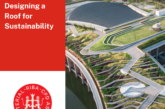James Scully, Managing Director at Quadrant, discusses the circular economy route to genuinely sustainable construction and the benefits of specifying cork flooring.
The leaders of the top world economies met at the G7 Summit in June to discuss sustainability among other global issues. The UK, who hosted the event in Cornwall, has already enshrined into law a commitment to meet net zero emission targets set for 2050. However, to meet this ambitious target all contributors must play their part.
The construction sector is one of the largest contributors of carbon emissions and its challenge now is to find and use more eco-friendly and sustainable building solutions to drastically reduce its output. Research shows there is overwhelming public support for sustainable development as the issues of climate change and global warming come to a head. Genuine sustainability means having an all-encompassing solution. One that promotes the wellbeing of its occupiers, adds value for building owners and is designed to work in hand with its surrounding natural environment and supports minimum material wastage and lower energy bills.
Many governments around the world are driving the use of circular economy strategies. These aim to minimise or even eliminate waste and pollution by improving efficiency and keeping products and materials in use. In construction, this includes all aspects from the design phase through building, usage and eventually deconstruction and recycling. The UK Government’s construction policy encourages the use of Modern Methods of Construction (MMC), which includes modular and offsite construction and digital working. In fact, government (including wider public sector) spending on modular buildings stands at £750m per year, making it an area of growth that should encourage more players in the construction industry to get involved.

Waste reduction
Currently, only 40% of construction waste is recycled or reused and most of the recycled materials are downcycled for second-grade construction like roads, rather than new buildings. To remedy this, forward-thinking projects are increasingly incorporating more sustainable measures in their designs, plans and processes. This approach is widely embraced by public sector priority programmes in the schools, hospitals, and housing sectors.
One of the ways public sector specifiers are incorporating green practices into their projects is with the use of recyclable and reusable materials. Along with recycled steel, cork flooring is proving to be a popular choice for specification as it is made from recycled cork and is infinitely recyclable and reusable.
What makes cork truly sustainable is the fact that as a raw material it is usually harvested from a living tree, as it is a tree bark, which continues to grow and reproduce more cork. And for every tonne of cork produced, it is estimated that cork oak forests absorb around 73 tonnes of carbon dioxide. The knock-on effect is a reduction in greenhouse gas emissions and slowing climate change.
Even after manufacture, cork flooring materials are infinitely recyclable as they retain the ability to store carbon dioxide throughout their entire lifecycle. Sustainable cork flooring is also produced within a circular economy model that upcycles waste and used corks from the bottle stopper industry. As a result, the best cork flooring manufacturers are building on the natural sustainability of cork by recycling cork products because they can be reconfigured and reused repeatedly without compromise.
Cork’s resistance to wear, resilience, flexibility, and ability to revert to its original shape after enduring sustaining pressure are not the only characteristics that make it the ideal sustainable flooring material. The health and wellbeing of a building’s user must also be considered. In this regard, cork is carbon neutral and has properties that help reduce acoustic noise by up to 50%, a plus for busy spaces such as in offices, schools, and hospitals.

Free of VOCs
Understanding the impact chemicals within building materials have on human health must also be considered when discussing sustainable construction. Flooring products should therefore be free from volatile organic compounds (VOCs) in line with current UK and EU indoor air quality standards.
A circular approach in construction will increase the amount of recycling and reusing of resources, while reducing the amount of waste that it leaves. Having a robust, well-designed build process, which uses technological and innovative solutions, can aid the transition to a more sustainable and cost-effective future for the entire industry and benefit our environment for future generations.
The benefits of a circular economy approach stretch beyond the ecological. It has the potential to provide further social and economic benefits, for example, the creation of recycling and upcycling businesses with the sole aim of supplying the construction industry with sustainable building materials, which in turn can create jobs for local economies. Collaboration between clients, engineers, contractors, architects, designers, and manufacturers is a must to create an entirely new construction ecosystem that is truly sustainable.
Header image shows the AKO Sixth Form Centre in Hampstead, London, designed by Lewandowski Architects. Photography ©Jack Hobhouse









